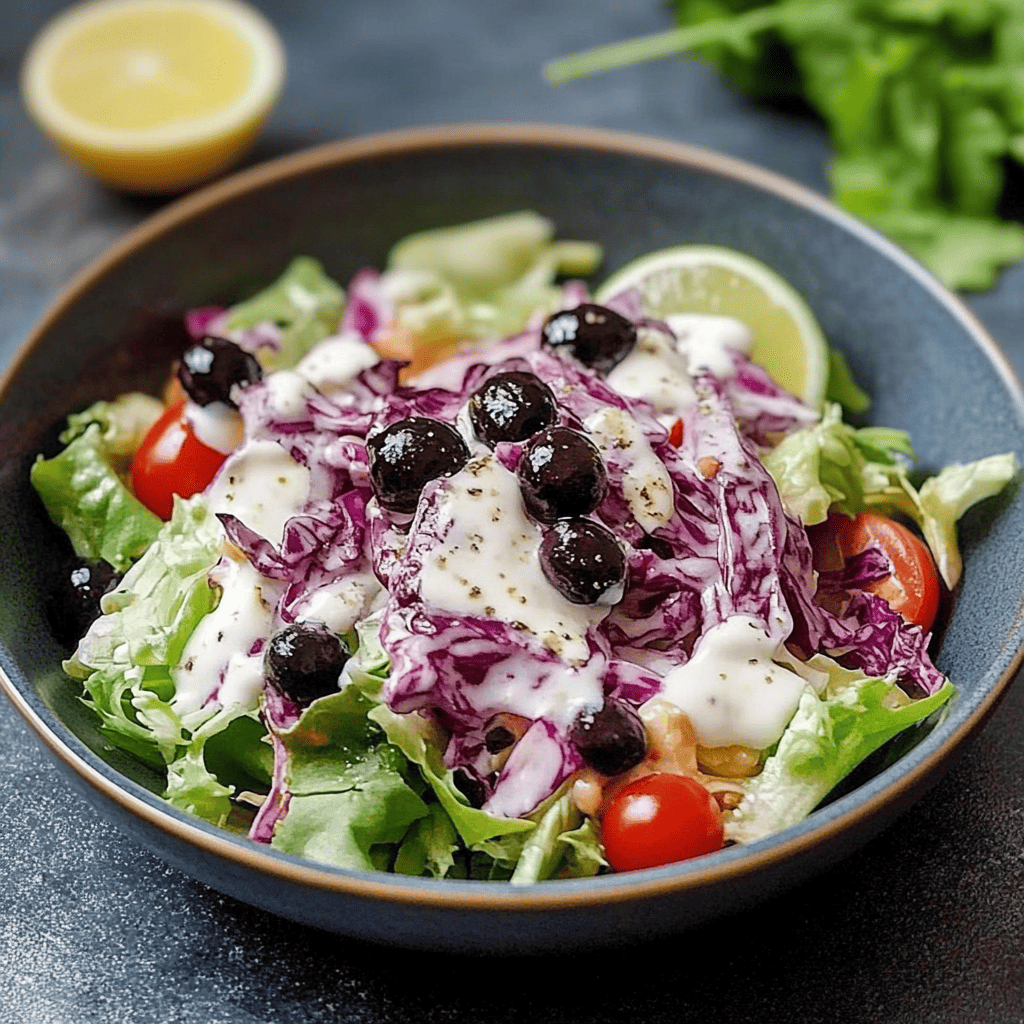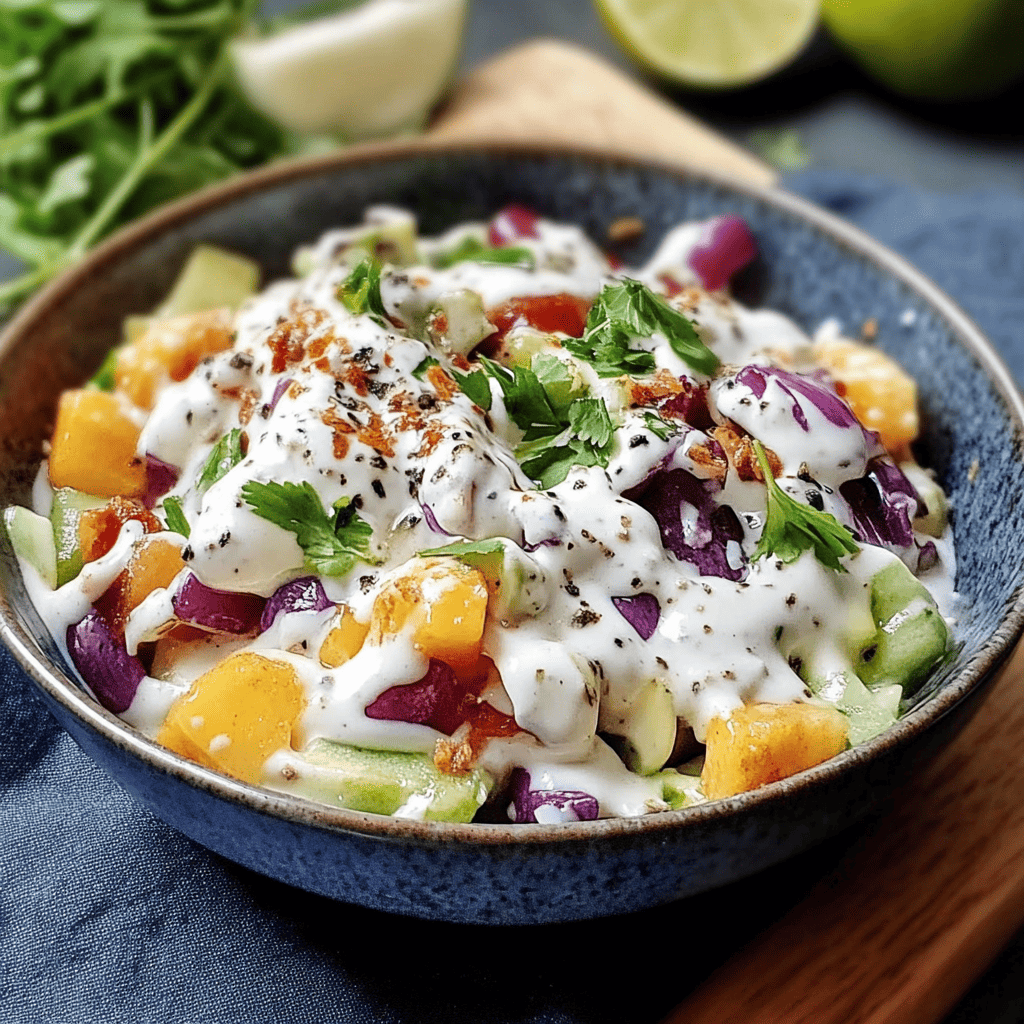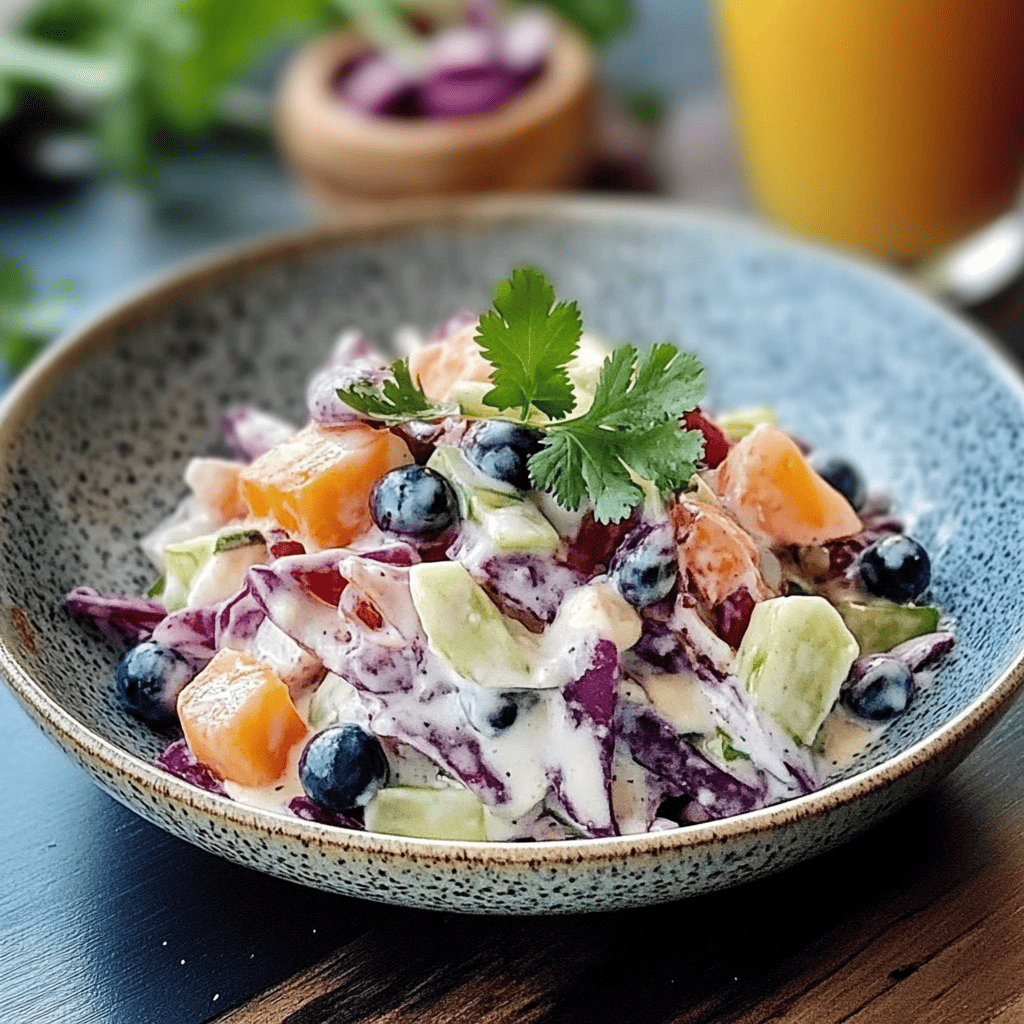Blueberry Yogurt Cabbage Salad: Freshness, Flavor, and Nutrition in Every Bite
Introduction: A Healthy and Delicious Twist on the Classic Salad
In the world of salads, few are as versatile and beloved as coleslaw . However, this recipe, “Cabbage Salad with Yogurt and Blueberries,” transcends the boundaries of convention to offer a fresh, vibrant, and surprisingly nutritious experience. This salad is not only a feast for the palate but also for the eyes, with its attractive purple cabbage, the blue flecks of blueberries, and the creamy white of its yogurt dressing. It’s a culinary proposition that redefines coleslaw, turning it into a light yet hearty dish, perfect for any occasion, from a quick lunch to a star side dish at a summer barbecue. Its combination of crunchy textures, sweet and sour flavors, and the healthy touch of Greek yogurt positions it as an ideal option for those looking to take care of their diet without sacrificing the pleasure of eating.
Detailed History: From Dutch Roots to Modern Innovation
The history of coleslaw is fascinating and dates back centuries. The term ” coleslaw ” comes from the Dutch word “koolsla,” an abbreviation of “koolsalade,” which literally means “college salad.” Cabbage, a vegetable cultivated since ancient times, has been a staple food in many cultures due to its hardiness, ease of cultivation, and nutritional value.
The Romans already consumed cabbage in salads with vinegar, and by the Middle Ages it was a common ingredient in Europe. However, the modern version of coleslaw as we know it, with shredded cabbage and a creamy dressing, began to gain popularity in the Netherlands. Dutch settlers brought this tradition to America, where it took root and evolved.
The earliest documented coleslaw recipes from the 18th century often used dressings based on melted butter, vinegar, and spices. With the invention of mayonnaise in the late 18th century and its subsequent commercial production in the 19th century, mayonnaise became the predominant ingredient in coleslaw dressings in America and other parts of the world.
Throughout the 20th century, coleslaw established itself as a classic side dish, especially in American cuisine, where it’s commonly served with barbecue, pulled pork sandwiches, and fried chicken. However, with the growing interest in healthy eating and fat reduction, there was a need to reinvent the classics.
This is where the “Blueberry Yogurt Cabbage Salad” comes in. This modern take is a testament to the evolution of cuisine and the constant search for balance between flavor, nutrition, and innovation. Replacing mayonnaise with natural Greek yogurt is a brilliant adaptation that significantly reduces the fat and calorie content, while adding a touch of probiotics and a lighter, more tangy texture. The addition of blueberries and apple is not just an aesthetic or flavor choice, but also a nutritional one. Blueberries, loaded with antioxidants, and apple, with its fiber and natural sweetness, perfectly complement the cabbage base, elevating the dish’s nutritional and flavor profile.
More Details of the Story: The Influence of Healthy Eating and Globalization
The popularization of blueberry and yogurt-based cabbage salad reflects several culinary and health trends that have gained momentum in recent decades. First and foremost, the search for healthier alternatives for dressings. Greek yogurt, with its high protein content and superior nutritional profile compared to mayonnaise, has become a star ingredient in healthy cooking. Its natural acidity and creamy texture make it ideal for salad dressings, sauces, and desserts.
Second, the growing appreciation for “superfoods.” Blueberries, in particular, have been the subject of numerous studies for their antioxidant properties and health benefits. Adding them to a salad not only improves the flavor and texture but also increases its nutritional value. Apples, meanwhile, add extra freshness and crunch, in addition to their natural sweetness that balances the acidity of the yogurt and lemon.
Finally, globalization and cultural exchange have allowed recipes to travel and adapt. Chefs and home cooks around the world have taken the base of coleslaw and transformed it with local ingredients or a focus on health. This particular salad is an example of how a traditional dish can be reinvented to meet the demands of a modern, health-conscious lifestyle, without losing its comforting and delicious essence. It’s not just a salad; it’s a statement that healthy food can be incredibly tasty and visually appealing.

Ingredients: A Harmony of Freshness and Nutrition
For the Salad Base:
- Juice of ½ fresh lemon
- 1 large carrot, grated
- ½ cup dried cranberries (or fresh cranberries, if you prefer)
- ½ white cabbage, finely shredded or chopped
- ½ red cabbage, finely shredded or chopped
- ½ cup chopped walnuts (optional, but highly recommended for a crunchy and nutritional touch)
- 1 green apple, cut into small cubes
For the Creamy Yogurt Dressing:
- 1 cup plain Greek yogurt (can be low-fat or fat-free for a lighter option)
- 1 tablespoon honey or agave syrup (adjust to taste for sweetness)
- 1 teaspoon mild mustard (Dijon or honey mustard, optional for a spicy and umami touch)
- Salt to taste
- Freshly ground black pepper to taste
Detailed Preparation: Steps to Create an Exceptional Salad
Step 1: Preparing the Crispy Vegetables
- Wash and Slice the Cabbage: Start by thoroughly washing both cabbages (white and purple) under cold water. Remove any damaged outer leaves. For a thin, even slice, you can use a mandoline (with caution), a food processor with a shredding blade, or, if you have the patience and a sharp knife, you can slice it by hand into very thin strips (julienne). It’s important to have thin strips so the salad has a delicate texture and the dressing adheres well.
- Grate the Carrot: Peel the large carrot and grate it using a coarse grater or the grater attachment on your food processor.
- Cut the Apple and Protect It from Browning: Wash the green apple and cut it into small cubes. It’s important to keep them small so they blend well into the salad and add a pleasant crunch to every bite. Immediately after cutting, sprinkle the apple cubes with the juice of ½ lemon. Mix well. This step is crucial to prevent the apple from oxidizing and browning, maintaining its attractive color and freshness.
Step 2: Combining the Salad Base
- In a large bowl, roomy enough to comfortably mix all the ingredients, add the shredded white cabbage, shredded red cabbage, shredded carrot, dried cranberries, and lemon apple cubes.
- If you’ve decided to use chopped walnuts, add them to the bowl now. The walnuts will provide a textural contrast and a delicious flavor that complements the other ingredients.
Step 3: Creating the Creamy Yogurt Dressing
- In a small container or separate bowl, pour the cup of plain Greek yogurt.
- Add the tablespoon of honey (or agave syrup) and the teaspoon of mild mustard (if using). The mustard, although optional, adds a slight complexity and umami touch that enhances the flavor of the dressing without overpowering it.
- Season with salt and black pepper to taste.
- Using a fork or small whisk, mix all the dressing ingredients until fully combined and the mixture is smooth and creamy.
- Taste and Adjust: This is a crucial step. Taste the dressing and adjust the amounts of honey, mustard, salt, or pepper according to your personal preference. If you like it sweeter, add a little more honey. If you want a more acidic note, you can add a few more lemon juice.
Step 4: Mixing and Cooling to Integrate Flavors
- Pour all of the creamy yogurt dressing over the dry salad ingredients in the large bowl.
- Using two large spoons or spatulas, mix gently but thoroughly until all vegetables, fruits, and nuts are evenly coated with the dressing. Make sure no undressed cabbage pieces remain.
- Cover the bowl with plastic wrap or a tight-fitting lid.
- Refrigeration: Place the salad in the refrigerator for at least 30 minutes. This resting time is crucial, as it allows the flavors to blend and develop, and the cabbage to soften slightly, absorbing some of the dressing. The salad will be much more flavorful, and the textures will have blended better.
Step 5: Serve and Enjoy
- Just before serving, give the salad a quick final toss, as the dressing tends to settle to the bottom.
- Serve the salad cold. You can present it in a large salad bowl or in individual portions.
- Serving Suggestions: It’s a perfect side dish for grilled meats (chicken, pork, fish), burgers, sandwiches, or tacos. It can also be served as a light and refreshing main course, especially on hot days. If desired, garnish with fresh parsley or cilantro leaves just before serving for a touch of color and aroma.
Estimated Preparation Time
- Active Preparation: 20-25 minutes (depending on cabbage cutting skills)
- Refrigerator Resting Time: Minimum 30 minutes (ideally 1-2 hours for better flavor integration)
- Estimated Total Time: 50 minutes to 1 hour 30 minutes
Additional Tips for a Perfect Salad
- Cabbage Thickness: The key to a good texture in this salad is finely shredded cabbage. If the shreds are too thick, the salad may end up too fibrous.
- Dried Fruit Variation: If you don’t have dried cranberries, you can try raisins, dried cherries, or even chopped dried apricots. Each will add a slightly different sweetness and texture.
- Add Crunchy Texture: If nuts aren’t your thing or you have allergies, you can omit them or replace them with roasted sunflower seeds, pumpkin seeds, flaked almonds, or even croutons for an extra crunch.
- Sweetness Adjustment: The amount of honey can vary depending on your taste and the acidity of the yogurt. Taste the dressing and adjust until you find the perfect balance.
- Prep Ahead: This salad is fantastic to prepare in advance, as the flavors settle and deepen over time. However, don’t prepare it too far in advance (more than 4-6 hours) to prevent the cabbage from becoming too soft. Walnuts, if using, are best added just before serving to maintain their crunch.
- Herb Variations: In addition to parsley, you can add other chopped fresh herbs to the dressing or salad, such as dill, mint, or cilantro, for a different flavor profile.
- Citrus Twist: For an even fresher flavor, you can add lemon zest to the dressing along with the juice.

Frequently Asked Questions and Clear Answers
- Can I use just one type of cabbage? Yes, you can use just white cabbage or just purple cabbage, but combining both provides a better color contrast and a slight difference in texture.
- Can you substitute Greek yogurt? You can try sour cream for a richer dressing, or mayonnaise for a more traditional version, but these options will significantly change the nutritional and flavor profile of the original yogurt recipe.
- How long does the salad last? Refrigerated in an airtight container, the salad will keep well for 2-3 days. It’s best to eat it within the first 24 hours to enjoy the cabbage’s best texture.
- Should cranberries be dried? Dried cranberries provide a concentrated sweetness and a chewy texture. You can use fresh cranberries if you prefer, but the flavor will be more tart and the texture different.
- Can I add other vegetables? Absolutely. Shredded broccoli, grated cauliflower, chopped bell peppers, or finely sliced red onion are all excellent additions.
Texture and Flavor: An Explosion of Freshness
- Texture: The Blueberry Yogurt Cabbage Salad offers a rich and varied textural experience. The cabbage (white and purple) and carrot provide a crisp, fresh base. The dried cranberries add a chewy, sweet contrast, while the diced green apple contributes a juicy crunch and a fresh note. Adding walnuts provides a toasted, crunchy note that elevates the salad’s complexity. The yogurt dressing, meanwhile, is creamy and smooth, uniting all the ingredients in a harmonious texture.
- Flavor: The flavor profile of this salad is bright and balanced. A combination of sweetness, acidity, and freshness predominates. The sweetness comes from the cranberries and honey in the dressing. The acidity is provided by the lemon in the apple and the Greek yogurt, which also introduces a slight dairy note. Mustard, when used, adds a subtle spicy, unami note that enhances the overall flavor. The cabbage and carrot have an earthy, slightly peppery flavor that is mellowed by the dressing, while the green apple adds a refreshing fruity note. It’s a clean, vibrant, and very appetizing flavor, ideal for cleansing the palate.
Consumption Context: When to Enjoy It?
This salad is incredibly versatile and adapts to numerous situations:
- Classic Side Dish: It’s a stellar side dish for barbecues, cookouts, and picnics. It pairs wonderfully with roasted meats, grilled chicken, fish, and burgers.
- Light Lunch: On its own, with a good portion, it can be a light, nutritious and satisfying lunch, especially on hot days.
- Meal Prep: Ideal for preparing in advance and having healthy meals ready to take to work or school.
- Informal Dinners: Perfect for informal dinners with friends or family, where you’re looking for something easy to prepare but full of flavor.
- Fresh Summer Dish: Its refreshing nature makes it a must-have for the summer months.
- Vegetarian/Vegan Option (Adjustment): This is a great vegetarian option and can be adapted for vegans by replacing the Greek yogurt with unsweetened plant-based yogurt and the honey with agave syrup.
Visual Aspect: A Rainbow on the Plate
The Blueberry Yogurt Cabbage Salad is a work of visual art in itself, as seen in the image.
- Vibrant Colors: The mix of purple and white cabbage creates a striking visual contrast, accentuated by the bright orange of the shredded carrots.
- Color Spots: Scattered blueberries add bright spots of color that break up the uniformity.
- Creamy and Enveloping: The creamy white yogurt dressing generously covers all the ingredients, giving it a delicious and succulent appearance.
- Fresh and Bright: The presence of fresh herbs (like parsley in the picture) as a garnish not only adds a vibrant touch of green, but also enhances the fresh feeling of the dish.
- Appealing Texture: The salad has an appealing visual texture, with the thin strips of cabbage and small pieces of apple and carrot suggesting a crunchy experience.
Curiosities: Interesting Facts about the Ingredients
- Purple Cabbage Power: Purple cabbage gets its color from compounds called anthocyanins, which are powerful antioxidants and are also found in blueberries. These anthocyanins are pH-sensitive, so the color of purple cabbage can change to a more blueish or greenish hue if cooked with alkaline ingredients.
- History of the Carrot: The carrot is native to Central Asia and was first cultivated for its aromatic leaves and seeds, not its root. The earliest carrots were purple or yellow, and the orange variety we know today was developed in the Netherlands in the 17th century.
- Blueberry Superpowers: Blueberries are famous for their high antioxidant content, especially anthocyanins, which may help protect cells from damage and support brain and eye health.
- Greek Yogurt: This is a version of yogurt that has been strained to remove the whey, resulting in a thicker, creamier product with a significantly higher protein content than regular yogurt.
- Benefits of Walnuts: Walnuts are an excellent source of plant-based omega-3 fatty acids, antioxidants, fiber, and protein, making them a superfood for brain and heart health.
Nutritional Value (Estimated per Serving)
Nutritional values are approximate and may vary depending on the exact quantities and brands of ingredients. For a generous serving (approximately 200-250g) of this salad, we can estimate:
- Calories: 180-250 kcal (significantly less than a coleslaw with mayonnaise)
- Protein: 8-12g (thanks to Greek yogurt and nuts)
- Total Fat: 8-15g (mostly healthy fats from nuts and yogurt)
- Carbohydrates: 20-30g (from vegetables, fruits and honey)
- Fiber: 5-8g (high in fiber due to cabbage, carrots, blueberries and nuts)
- Sugars: 10-18g (natural sugars from fruit and honey)
- Sodium: 100-250mg (depending on added salt)
Additional Benefits and Interesting Facts
- Digestive Health: The high fiber content of cabbage, carrots, and blueberries, combined with the probiotics in Greek yogurt, contributes to healthy digestion and intestinal well-being.
- Powerful Antioxidants: Thanks to the blueberries, red cabbage, and apple, this salad is a powerhouse of antioxidants that help fight free radical damage in the body.
- Low in Calories and Rich in Nutrients: It’s an excellent option for those looking to lose weight or maintain a healthy weight, as it’s low in calories but dense in essential nutrients.
- Adaptability: The recipe is easily adaptable to different tastes and dietary needs, allowing for ingredient substitutions and flavor adjustments.
- Easy to Prepare: Despite its sophisticated appearance, this is a very simple and quick salad to prepare, ideal for cooks of all levels.
Other Information
- Allergies: This dish contains dairy (yogurt) and nuts (walnuts, if used). Consider alternatives if you have allergies.
- Storage: Ideally, consume it the same day or the next day. Cabbage can release water over time, affecting its texture if stored for too long.
- Reheating: This salad is not reheatable. It’s best enjoyed cold.
- Sustainability: Using seasonal and locally sourced vegetables enhances flavor and supports sustainability.

Conclusion: The Salad That Has It All
“Cocktail Salad with Yogurt and Blueberries” is much more than a simple side dish; it’s a culinary statement. It represents the perfect fusion of tradition and modernity, health and gastronomic pleasure. With its dazzling color palette, its harmony of crunchy and creamy textures, and its explosion of sweet, tangy, and fresh flavors, this salad is positioned as a must-have dish in any repertoire. It is proof that healthy food can be not only delicious, but also inspiring and visually captivating. Ideal for any occasion, from a revitalizing lunch to a sophisticated addition to a celebration, this salad is a gift for the palate and a balm for well-being.

